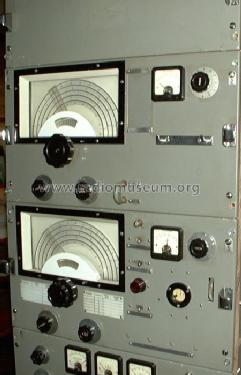- Country
- Great Britain (UK)
- Manufacturer / Brand
- Marconi Co. (Marconiphone, Marconi's Wireless Telegraph Co. Ltd.), GB (not tubes - see also HMV His Master's Voice)
- Year
- 1955 ??
- Category
- Commercial Receiver (may include amateur bands)
- Radiomuseum.org ID
- 101107
- Number of Tubes
- 52
- Main principle
- Superheterodyne (common)
- Wave bands
- Short Wave (SW only)
- Power type and voltage
- Alternating Current supply (AC) / 220 Volt
- Loudspeaker
- Permanent Magnet Dynamic (PDyn) Loudspeaker (moving coil) / Ø 12 cm = 4.7 inch
- Power out
- 4 W (unknown quality)
- Material
- Metal case
- from Radiomuseum.org
- Model: Marconi 2 - Marconi Co. Marconiphone,
- Shape
- Console with any shape - in general
- Dimensions (WHD)
- 484 x 1980 x 430 mm / 19.1 x 78 x 16.9 inch
- Notes
-
Röhren teilweise mehrfach vorhanden.
Der Empfänger wurde von der Radio-Schweiz für die Überseetelefonie verwendet. Der Empfänger besteht aus 8 19"-Einschüben. Bezeichnung der Einschübe:
1. Filter unit; 2. SF & IF unit; 3. 1st & 2nd Oszillator unit; 4. USB & Carrier unit; 5. LSB unit; 6. Supply unit1; 7. Supply unit2; 8. Speaker unit.
Frequenzbereich: 3 bis 28 Mhz.
Das Gerät ist vermutlich eine Einzelanfertigung für die Radio-Schweiz.We found a tube 5760 but are not sure if it existas at all and write here "unknown".
- Net weight (2.2 lb = 1 kg)
- 160 kg / 352 lb 6.8 oz (352.423 lb)
- Author
- Model page created by Alexander Küffer. See "Data change" for further contributors.
- Other Models
-
Here you find 503 models, 339 with images and 321 with schematics for wireless sets etc. In French: TSF for Télégraphie sans fil.
All listed radios etc. from Marconi Co. (Marconiphone, Marconi's Wireless Telegraph Co. Ltd.), GB (not tubes - see also HMV His Master's Voice)
Collections
The model Marconi is part of the collections of the following members.
Forum contributions about this model: Marconi Co.: Marconi 2
Threads: 1 | Posts: 1
The upper three units turn out to be three tuning units for diversity reception,
the reception of the same station / channel from different antennas to reduce fading (antenna diversity) or even reception of the same programming from different frequencies (frequency diversity) improves readibility of a signal:
Upper tuning unit:
and here the image of the middle tuning unit:
So in my opinion the set from Radio Schweiz is not a unique set, but built to customers specifications from different modules.
Hopefully, we might find more informations about this set or similar systems and what they might have been used for,
Martin Boesch
Martin Bösch, 24.Oct.07


